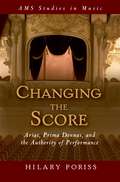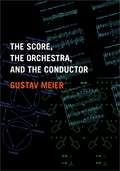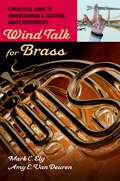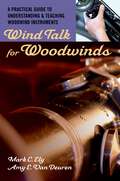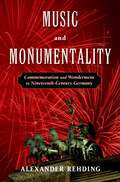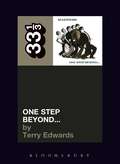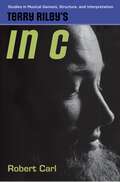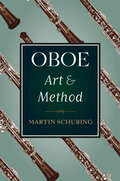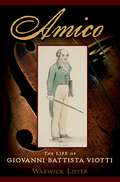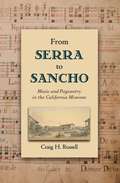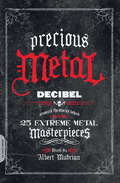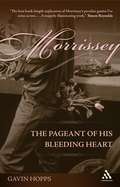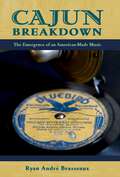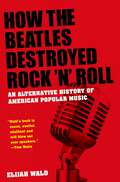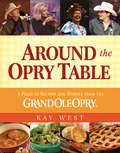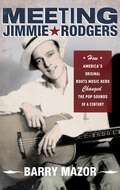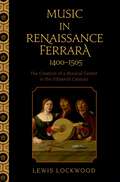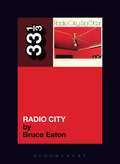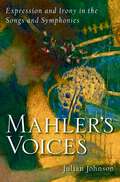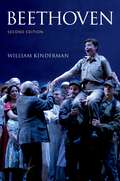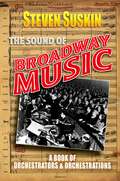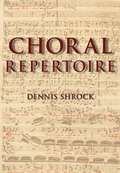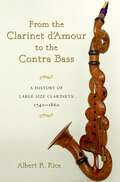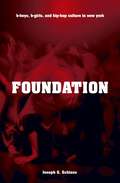- Table View
- List View
Changing the Score: Arias, Prima Donnas, and the Authority of Performance (AMS Studies in Music)
by Hilary PorissThis study seeks to explore the role and significance of aria insertion, the practice that allowed singers to introduce music of their own choice into productions of Italian operas. Each chapter investigates the art of aria insertion during the nineteenth century from varying perspectives, beginning with an overview of the changing fortunes of the practice, followed by explorations of individual prima donnas and their relationship with particular insertion arias: Carolina Ungher's difficulties in finding a "perfect" aria to introduce into Donizetti's Marino Faliero; Guiditta Pasta's performance of an aria from Pacini's Niobe in a variety of operas, and the subsequent fortunes of that particular aria; Maria Malibran's interpolation of Vaccai's final scene from Giulietta e Romeo in place of Bellini's original setting in his I Capuleti e i Montecchi; and Adelina Patti's "mini-concerts" in the lesson scene of Il barbiere di Siviglia. The final chapter provides a treatment of a short story, "Memoir of a Song," narrated by none other than an insertion aria itself, and the volume concludes with an appendix containing the first modern edition of this short story, a narrative that has lain utterly forgotten since its publication in 1849. This book covers a wide variety of material that will be of interest to opera scholars and opera lovers alike, touching on the fluidity of the operatic work, on the reception of the singers, and on the shifting and hardening aesthetics of music criticism through the period.
The Score, the Orchestra, and the Conductor
by Gustav MeierKnown internationally for his work as a teacher of conducting, Gustav Meier's influence in the field cannot be overstated. In The Score, the Orchestra and the Conductor, Meier demystifies the conductor's craft with explanations and illustrations of what the conductor must know to attain podium success. He provides useful information from the rudimentary to the sophisticated, and offers specific and readily applicable advice for technical and musical matters essential to the conductor's first rehearsal with the orchestra. This book details many topics that otherwise are unavailable to the aspiring and established conductor, including the use of the common denominator, the "The ZIG-ZAG method", a multiple, cross-indexed glossary of orchestral instruments in four languages, an illustrated description of string harmonics, and a comprehensive listing of voice categories, their overlaps, dynamic ranges and repertory. The Score, the Orchestra and the Conductor is an indispensable addition to the library of every conductor and conducting student.
Wind Talk for Brass: A Practical Guide to Understanding and Teaching Brass Instruments
by Mark C. Ely Amy E. Van DeurenWind Talk for Brass provides instrumental music teachers, practitioners, and students with a handy, easy-to-use pedagogical resource for brass instruments found in school instrumental programs. With thorough coverage of the most common brass instruments - trumpet, horn, trombone, baritone/euphonium, and tuba/sousaphone - the book offers the most topical and information necessary for effective teaching. This includes terminology, topics, and concepts associated with each specific instrument, along with teaching suggestions that can be applied in the classroom. Be sure to look to the back of the book for a "Practical Tips" section, which discusses common technical faults and corrections, common problems with sound (as well as their causes and solutions to them), fingering charts, literature lists (study materials, method books, and solos), as well as a list of additional resources relevant to teaching brass instruments (articles, websites, audio recordings). Without question, Wind Talk for Brass stands alone as an invaluable resource for woodwinds!
Wind Talk for Woodwinds: A Practical Guide to Understanding and Teaching Woodwind Instruments
by Mark C. Ely Amy E. Van DeurenWind Talk for Woodwinds provides instrumental music teachers, practitioners, and students with a handy, easy-to-use pedagogical resource for woodwind instruments found in school instrumental programs. With thorough coverage of the most common woodwind instruments - flute, oboe, clarinet, saxophone, and bassoon - the book offers the most topical and information necessary for effective teaching. This includes terminology, topics, and concepts associated with each specific instrument, along with teaching suggestions that can be applied in the classroom. Be sure to look to the back of the book for a "Practical Tips" section, which discusses common technical faults and corrections, common problems with sound (as well as their causes and solutions to them), fingering charts, literature lists (study materials, method books, and solos), as well as a list of additional resources relevant to teaching woodwind instruments (articles, websites, audio recordings). Without question, Wind Talk for Woodwinds stands alone as an invaluable resource for woodwinds!
Music and Monumentality: Commemoration and Wonderment in Nineteenth Century Germany
by Alexander RehdingThis critical study locates musical monumentality, a central property of the nineteenth-century German repertoire, at the intersections of aesthetics and memory. In examples including Beethoven, Liszt, Wagner and Bruckner, Rehding explores how monumentality contributes to an experiential music history and how it conveys the sublime to the listening public.
Madness' One Step Beyond... (33 1/3)
by Terry EdwardsOne Step Beyond isn't the best album in the world - it's not even the best album by Madness. It is, however, a great record and an exceptional debut album -fully formed despite half the band still being in their teens - and it remains as exhilarating, inspiring and as much fun as when people first heard it nearly 30 years ago. Through extensive interviews with the band, as well as producers Clive Langer & Alan Winstanley, Terry Edwards tells the inside story of how Madness rose to be the most successful singles band of the 1980s in the UK charts.
Terry Riley's In C (Studies in Musical Genesis, Structure, and Interpretation)
by Robert CarlSetting the stage for a most intriguing journey into the world of minimalism, Robert Carl's Terry Riley's In C argues that the work holds its place in the canon because of the very challenges it presents to "classical" music. Carl examines In C in the context of its era, its grounding in aesthetic practices and assumptions, its process of composition, presentation, recording, and dissemination.
Oboe Art and Method
by Martin SchuringIn Oboe Art and Method, veteran oboe performer and instructor Martin Schuring describes in detail all of the basic techniques of oboe playing and reed making, with expert tips and step-by-step instructions for how best to perform each of these tasks with grace and technical efficiency. Schuring's straightforward and articulate explanations of breathing, embouchure, finger technique, articulation, phrasing, and more help demystify the earliest stages of oboe playing and beyond. In addition, Schuring provides excellent advice on the "extra-musical"; practicing, instrument care and adjustment, professional development, and career development-related issues. The oboe is a notoriously complicated instrument, and this book aims to remove as much of the complexity as possible, to present techniques that work, and to discuss these in a clear-cut manner. Students who start with this book will learn with confidence that these methods will steer them straight down an effective path. A concise and eminently useful guide, Oboe Art and Method is a must-have for all who perform, teach, or are learning to play the oboe, in both conservatories and private instruction.
Amico: The Life of Giovanni Battista Viotti
by Warwick ListerThis is the first full-length biography in English of Giovanni Battista Viotti (1755-1824), one of the great violinist-composers in the history of music, and arguably the most influential violinist who ever lived. This study is based on extensive documentary research, much of it here revealed for the first time.
From Serra to Sancho: Music and Pageantry in the California Missions (Currents in Latin American and Iberian Music)
by Craig H. RussellMusic in the California missions was a pluralistic combination of voices and instruments, of liturgy and spectacle, of styles and functions--and even of cultures--in a new blend that was non-existent before the Franciscan friars made their way to California beginning in 1769. From Serra to Sancho explores the exquisite sacred music that flourished on the West Coast of the United States when it was under Spanish and Mexican rule, delving into the historical, cultural, biographical, and stylistic aspects of California mission music during the late eighteenth and early nineteenth centuries. Author Craig H. Russell examines how mellifluous plainchant, reverent hymns, spunky folkloric ditties, "classical" music in the style of Haydn, and even Native American drumming were interwoven into a tapestry of resonant beauty. In addition to extensive musical and cultural analysis, Russell draws upon hundreds of primary documents in California, Mexico, Madrid, Barcelona, London, and Mallorca. It is through the melding together of this information from geographically separated places that he brings the mystery of California's mission music into sharper focus. Russell's groundbreaking study sheds new light on the cultural exchange that took place in the colonial United States, as well as on the pervasive worldwide influence of Iberian music as a whole.
Precious Metal: Decibel Presents the Stories Behind 25 Extreme Metal Masterpieces
by Albert MudrianDecibel magazine is regarded as the best extreme music magazine around.Precious Metal gathers pieces from Decibel's most popular feature, the monthly &“Hall of Fame&” which documents the making of landmark metal albums via candid, hilarious, and fascinating interviews with every participating band member.Decibel's editor-in-chief Albert Mudrian, has selected and expanded the best of these features, creating a definitive collection of stories behind the greatest extreme metal albums of all time.
Morrissey: The Pageant of His Bleeding Heart
by Gavin HoppsMorrissey is arguably the greatest disturbance popular music has ever known. Even more than the choreographed carelessness of punk and the hyperbolic gestures of glam rock and the New Romantics, Morrissey's early bookish ineptitude, his celebration of the ordinary, and his subversive endorsement of celibacy, abstinence and rock 'n' roll revolutionized the world of British pop. As a solo artist, too, he consistently adopts the outsider's perspective and dares us to confront uncomfortable subjects. In his brilliant book, Gavin Hopps examines the work of this compelling performer, whose intelligence, humour, suffering and awkwardness have fascinated audiences around the world for the last 25 years.Hopps traces the trajectory of Morrissey's career and outlines the contours and contradictions of the singer's elusive persona. The book illuminates Morrissey's coyness (how can he remain a mystery when he tells us too much?), his dramatized melancholy (surely more of a radical existential protest than the gimmick some believe it to be), and his complex attitudes towards loneliness and alienation, as well as his intriguing sense of the religious.
Cajun Breakdown: The Emergence of an American-Made Music (American Musicspheres)
by Ryan Andre BrasseauxIn 1946, Harry Choates, a Cajun fiddle virtuoso, changed the course of American musical history when his recording of the so-called Cajun national anthem "Jole Blon" reached number four on the national Billboard charts. Cajun music became part of the American consciousness for the first time thanks to the unprecedented success of this issue, as the French tune crossed cultural, ethnic, racial, and socio-economic boundaries. Country music stars Moon Mullican, Roy Acuff, Bob Wills, and Hank Snow rushed into the studio to record their own interpretations of the waltz-followed years later by Waylon Jennings and Bruce Springsteen. The cross-cultural musical legacy of this plaintive waltz also paved the way for Hank Williams Sr.'s Cajun-influenced hit "Jamabalaya." Choates' "Jole Blon" represents the culmination of a centuries-old dialogue between the Cajun community and the rest of America. Joining into this dialogue is the most thoroughly researched and broadly conceived history of Cajun music yet published, Cajun Breakdown. Furthermore, the book examines the social and cultural roots of Cajun music's development through 1950 by raising broad questions about the ethnic experience in America and nature of indigenous American music. Since its inception, the Cajun community constantly refashioned influences from the American musical landscape despite the pressures of marginalization, denigration, and poverty. European and North American French songs, minstrel tunes, blues, jazz, hillbilly, Tin Pan Alley melodies, and western swing all became part of the Cajun musical equation. The idiom's synthetic nature suggests an extensive and intensive dialogue with popular culture, extinguishing the myth that Cajuns were an isolated folk group astray in the American South. Ryan André Brasseaux's work constitutes a bold and innovative exploration of a forgotten chapter in America's musical odyssey.
How the Beatles Destroyed Rock 'n' Roll: An Alternative History of American Popular Music
by Elijah Wald"There are no definitive histories," writes Elijah Wald, in this provocative reassessment of American popular music, "because the past keeps looking different as the present changes." Earlier musical styles sound different to us today because we hear them through the musical filter of other styles that came after them, all the way through funk and hip hop. As its blasphemous title suggests, How the Beatles Destroyed Rock 'n' Roll rejects the conventional pieties of mainstream jazz and rock history. Rather than concentrating on those traditionally favored styles, the book traces the evolution of popular music through developing tastes, trends and technologies--including the role of records, radio, jukeboxes and television --to give a fuller, more balanced account of the broad variety of music that captivated listeners over the course of the twentieth century. Wald revisits original sources--recordings, period articles, memoirs, and interviews--to highlight how music was actually heard and experienced over the years. And in a refreshing departure from more typical histories, he focuses on the world of working musicians and ordinary listeners rather than stars and specialists. He looks for example at the evolution of jazz as dance music, and rock 'n' roll through the eyes of the screaming, twisting teenage girls who made up the bulk of its early audience. Duke Ellington, Benny Goodman, Frank Sinatra, Elvis Presley, Chuck Berry, and the Beatles are all here, but Wald also discusses less familiar names like Paul Whiteman, Guy Lombardo, Mitch Miller, Jo Stafford, Frankie Avalon, and the Shirelles, who in some cases were far more popular than those bright stars we all know today, and who more accurately represent the mainstream of their times. Written with verve and style, How the Beatles Destroyed Rock 'n' Roll shakes up our staid notions of music history and helps us hear American popular music with new ears.
Around the Opry Table: A Feast of Recipes and Stories from the Grand Ole Opry
by Kay WestCountry music and country cooking fans everywhere will savor this new official cookbook of the Grand Ole Opry and its members, featuring favorite recipes of country music legends past and present and the stories behind them.
Meeting Jimmie Rodgers: How America's Original Roots Music Hero Changed the Pop Sounds of a Century
by Barry MazorIn Meeting Jimmie Rodgers, the first book to explore the deep legacy of "The Singing Brakeman" from a twenty-first century perspective, Barry Mazor offers a lively look at Rodgers' career, tracing his rise from working-class obscurity to the pinnacle of renown that came with such hits as "Blue Yodel" and "In the Jailhouse Now." As Mazor shows, Rodgers brought emotional clarity and a unique sense of narrative drama to every song he performed, whether tough or sentimental, comic or sad. His wistful singing, falsetto yodels, bold flat-picking guitar style, and sometimes censorable themes--sex, crime, and other edgy topics--set him apart from most of his contemporaries. But more than anything else, Mazor suggests, it was Rodgers' shape-shifting ability to assume many public personas--working stiff, decked-out cowboy, suave ladies' man--that connected him to such a broad public and set the stage for the stars who followed him. In reconstructing this far-flung legacy, Mazor enables readers to meet Rodgers and his music anew-not as an historical figure, but as a vibrant, immediate force.
Music in Renaissance Ferrara 1400-1505: The Creation of a Musical Center in the Fifteenth Century
by Lewis LockwoodBased on extensive documentary and archival research, Music in Renaissance Ferrara is a documentary history of music for one of the most important city-states of the Italian Renaissance. Lockwood shows how patrons and musicians created a musical center over the course of the fifteenth-century, tracing the growth of music and musical life in rich detail. It also sheds new light on the careers of such important composers as Dufay, Martini, Obrecht, and Josquin Desprez. This paperback edition features a new preface that re-introduces the book and reflects on its contribution to our modern knowledge of music in the culture of the Italian Renaissance.
Big Star's Radio City (33 1/3)
by Bruce EatonReleased when ELP and Elton John were plodding from one packed stadium to the next, Radio City was a radical album influenced by records that were already deemed oldies and yet sounding like a lean electrical jolt from the future. Here, Bruce Eaton examines the key ingredients of Radio City's lasting appeal- and through extensive interviews with all of those involved, gets to the heart of the cult of Big Star.
Mahler's Voices: Expression and Irony in the Songs and Symphonies
by Julian JohnsonMahler's Voices brings together a close reading of the renowned composer's music with wide-ranging cultural and historical interpretation, unique in being a study not of Mahler's works as such but of Mahler's musical style.
Mahler's Voices: Expression and Irony in the Songs and Symphonies
by Julian JohnsonMahler's Voices brings together a close reading of the renowned composer's music with wide-ranging cultural and historical interpretation, unique in being a study not of Mahler's works as such but of Mahler's musical style.
Beethoven
by William KindermanCombining musical insight with the most recent research, William Kinderman's Beethoven is both a richly drawn portrait of the man and a guide to his music. Kinderman traces the composer's intellectual and musical development from the early works written in Bonn to the Ninth Symphony and the late quartets, looking at compositions from different and original perspectives that show Beethoven's art as a union of sensuous and rational, of expression and structure. In analyses of individual pieces, Kinderman shows that the deepening of Beethoven's musical thought was a continuous process over decades of his life. In this new updated edition, Kinderman gives more attention to the composer's early chamber music, his songs, his opera Fidelio, and to a number of often-neglected works of the composer's later years and fascinating projects left incomplete. A revised view emerges from this of Beethoven's aesthetics and the musical meaning of his works. Rather than the conventional image of a heroic and tormented figure, Kinderman provides a more complex, more fully rounded account of the composer. Although Beethoven's deafness and his other personal crises are addressed, together with this ever-increasing commitment to his art, so too are the lighter aspects of his personality: his humor, his love of puns, his great delight in juxtaposing the exalted and the commonplace.
The Sound of Broadway Music: A Book of Orchestrators and Orchestrations
by Steven SuskinBroadway's top orchestrators - Robert Russell Bennett, Don Walker, Philip J. Lang, Jonathan Tunick - are names well known to musical theatre fans, but few people understand precisely what the orchestrator does. The Sound of Broadway Music is the first book ever written about these unsung stars of the Broadway musical whose work is so vital to each show's success. The book examines the careers of Broadway's major orchestrators and follows the song as it travels from the composer's piano to the orchestra pit. Steven Suskin has meticulously tracked down thousands of original orchestral scores, piecing together enigmatic notes and notations with long-forgotten documents and current interviews with dozens of composers, producers, conductors and arrangers. The information is separated into three main parts: a biographical section which gives a sense of the life and world of twelve major theatre orchestrators, as well as incorporating briefer sections on another thirty arrangers and conductors; a lively discussion of the art of orchestration, written for musical theatre enthusiasts (including those who do not read music); a biographical section which gives a sense of the life and world of twelve major theatre orchestrators, as well as incorporating briefer sections on another thirty arrangers and conductors; and an impressive show-by-show listing of more than seven hundred musicals, in many cases including a song-by-song listing of precisely who orchestrated what along with relevant comments from people involved with the productions. Stocked with intriguing facts and juicy anecdotes, many of which have never before appeared in print, The Sound of Broadway Music brings fascinating and often surprising new insight into the world of musical theatre.
Choral Repertoire
by Dennis ShrockChoral Repertoire is the definitive and comprehensive one-volume presentation of the canon of the Western choral tradition. Designed for practicing conductors and directors, students and teachers of choral music, amateur and professional singers, scholars, and interested vocal enthusiasts, it is an account of the complete choral output of the most significant composers of this genre throughout history. Organized by era (Medieval, Renaissance, Baroque, Classical, Romantic, and Modern), Choral Repertoire covers general characteristics of each historical era; trends and styles unique to various countries; biographical sketches of over 500 composers; and performance annotations of more than 5,000 individual works. This book will be an essential guide to programming, a reference tool for program notes and other research, and, most importantly, a key resource for conductors, instructors, scholars, and students of choral music.
From the Clarinet D'Amour to the Contra Bass: A History of Large Size Clarinets, 1740-1860
by Albert R. RiceFollowing his much-acclaimed The Baroque Clarinet and The Clarinet in the Classical Period, Albert R. Rice now turns his signature detailed attention to large clarinets - the clarinet d'amour, the basset horn, the alto clarinet, bass and contra bass clarinets. Each chapter is devoted to a specific instrument, and offers a fascinating insider's look at its defining characteristics, a comprehensive history of its evolution, meticulously-researched information on its makers and aspects of construction, and a thorough discussion of its music. Rice illustrates how the introduction of large clarinets into chamber ensembles, wind bands, and opera orchestras was the result of experiments meant to address specific musical needs. Along the way, he brings to life the musicians, virtuosi, soloists, and orchestral and band musicians, as well as the instruments' makers and the composers from J. C. Bach to Smetana who wrote for them. Based on careful study of primary sources - musical compositions, patents, memoirs and diaries, and unfettered access to historical instruments themselves--Rice's expert presentation is nothing short of exhaustive. From the Clarinet d'Amour to the Contrabass will engage all who love the clarinet and its music.
Foundation: B-boys, B-girls and Hip-Hop Culture in New York
by Joseph G. SchlossB-boying is a form of Afro-diasporic competitive dance that developed in the Bronx, NY in the early 1970s. Widely - though incorrectly - known as "breakdancing," it is often dismissed as a form of urban acrobatics set to music. In reality, however, b-boying is a deeply traditional and profoundly expressive art form that has been passed down from teacher to student for almost four decades. Foundation: B-boys, B-girls and Hip-Hop Culture in New York offers the first serious study of b-boying as both unique dance form and a manifestation of the most fundamental principles of hip-hop culture. Drawing on anthropological and historical research, interviews and personal experience as a student of the dance, Joseph Schloss presents a nuanced picture of b-boying and its social context. From the dance's distinctive musical repertoire and traditional educational approaches to its complex stylistic principles and secret battle strategies, Foundation illuminates a previously unexamined thread in the complex tapestry that is contemporary hip-hop.
